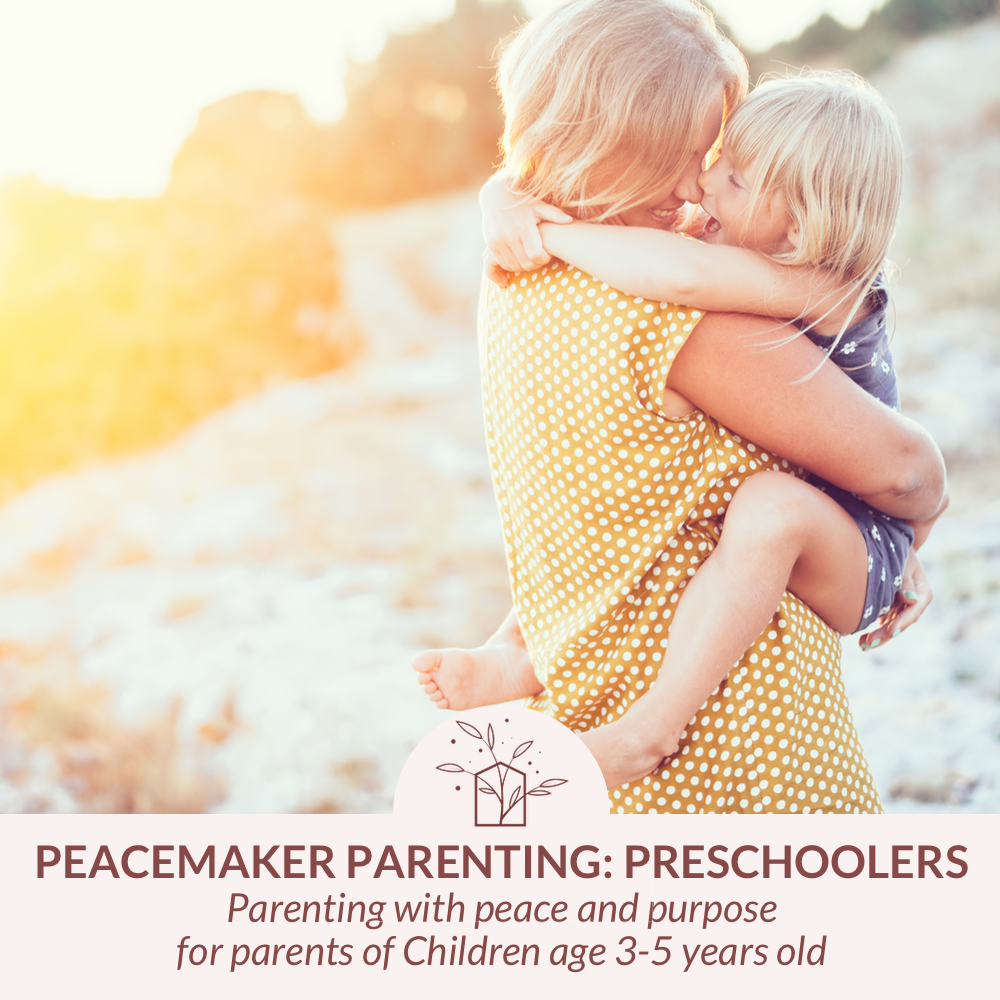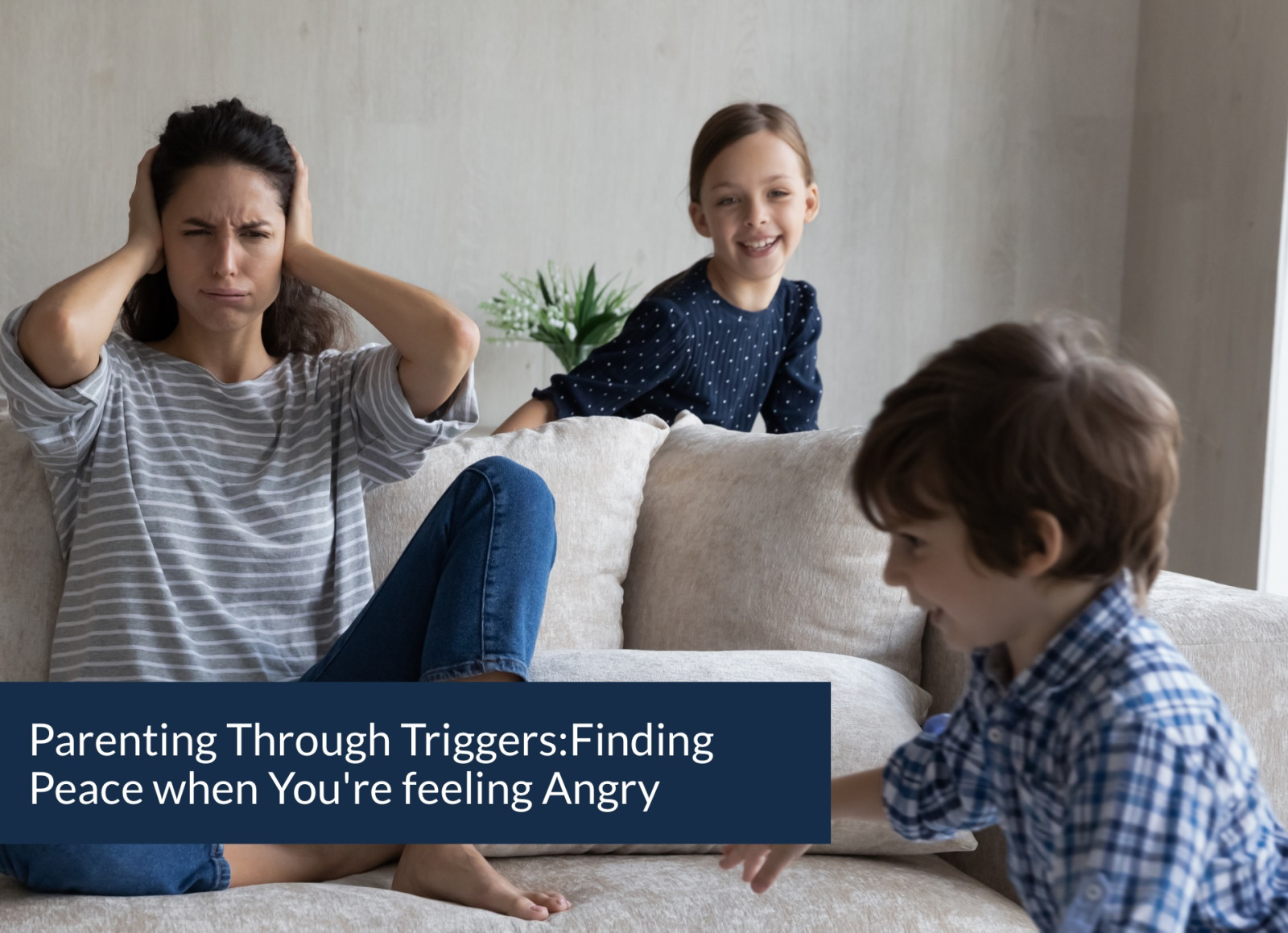Dear Dr. David + Amanda,
I'm reaching out because I'm having such a hard time dealing with my toddler's tantrums. It's like the "terrible twos" hit us like a tidal wave, and I'm left feeling lost every time my little one goes into meltdown mode. I've tried to do everything I can to avoid triggering him, but once he gets going, I just don’t know how to stop it. I don’t want to spank him or threaten her, but I don’t know what to do. Sometimes I try to be reassuring and he yells even more! Help a struggling mama out? -Alex
Hi Alex,
We can tell from your message that you care so much about your daughter, and truly want to help her, and we understand (from our own experience!) how chaotic those tantrums and meltdowns can be - for parent and child!
Read more...
Brooke, one of the moms in The Mentorship, shared this story with us recently that perfectly illustrates the Peacemaker Parenting approach to consequences:
"That last time we were at my mom's house, Eli (4) started playing with a ball inside. He wasn't being particularly naughty or disruptive with it, so we adults just sort of kept talking and didn't pay that much attention. Before I knew it, Eli had thrown the ball at just the right angle and knocked a picture off the credenza, breaking the glass. In the past I would have been very stern with him, scolded him for being naught, put him in time-out, and put the ball away. This time I tried to focus on future-facing consequences. Because there was glass involved I didn't make him help me clean it up. But we did talk to his Grandma and together we decided that Eli and I would go to the craft store and replace the glass in the frame. We also defined new expectations that balls are only for the back patio or back yard at Grandma's house. My mom is going to get an all-weather basket or tote to keep outside toys in for the future."
First, let us make this disclaimer perfectly clear, because sometimes it is misunderstood or misconstrued: Peacemaker Parenting does not avoid all consequences, and we personally don't believe consequences should never be used.
That being said, when a parent's mindset is heavily weighted towards consequences, they are more likely to fail at helping children learn the skills and tools, and gain the maturity needed to do better next time. Focusing on consequences is a backward-facing approach. Focusing on empowering is a forward-facing approach. This is why, in Peacemaker Parenting, we do not rely on consequences to hold boundaries and limits or to manage and control behavior.
HELP VS. HURT
Nearly every choice and behavior has a natural consequence or outcome, and those natural consequences can sometimes be the best teachers. When we settle into a consequence-heavy mindset, it is easy to unintentionally hurt our children with the consequence (which breaks trust and connection and inhibits their ability to learn to do better), rather than helping them know what or how to do differently next time. Rather than looking forward to what can be done differently next time, our child focuses on the imposed consequence (which can very easily just be a "punishment" delivered more gently).
Max Bledsoe, father of Drew Bledsoe and author of Parenting with Dignity explains why this can be counter productive:
"When a parent resorts to punishment, parent and child pay attention to the punishment, its fairness, and whether it has been enforced or followed. The child stops thinking about the decision process in his mind that brought about the negative consequences—and doesn’t think at all about what he might do differently."
EMPOWERING VS. IMPOSING
It isn't that there is never a need for logical consequences - there certainly are! But removing a child from a harmful situation or taking away something to keep it safe merely fixes the problem in the moment. Our children need to be patiently coached, guided, taught, and empowered with how to handle the same situation next time. Empowering them with emotional regulation tools, scripts for respectful conflict, and what or how to do better next time equips them for the future rather than punishing them for the past.
This is where future-facing consequences can be so life-giving.
FUTURE VS. PAST
Future-focused discipline allows us to evaluate our children as whole beings, taking into account their physical, emotional, and sensory needs, their personalities, and their development. That enables us as parents to create a robust and wholistic approach to empowering them for the future. This can take many forms, from practicing impulse control through classic childhood games like Simon Says and Red Light, Green Light, (which, admittedly may not feel very "discipline-y", but it is important to build and strengthen a child's impulse control "muscle" before placing an expectation on them that is rooted in controlling impulses and urges) to brainstorming a code word or private prompt for you to use when they need a gentle reminder to speak with respect and honor.
The summer our boys were 7 and 8 they struggled with sibling conflict more than what we thought was typical. It felt like every little thing turned into an explosive argument. By that time we'd spent a few years teaching them healthy conflict resolution, but all of it seemed to have gone out the window.
We could have punished them for fighting, or used a reward system to motivate them to focus on being kind to each other. Instead, we invited them to write and illustrate their own P.E.A.C.E. Plan. They spent a couple of hours one afternoon creating a conflict resolution guide customized to their personalities and needs, that they were then able to use any time they had disagreements or problems that needed intentional peace infused into the situation. This is a future-facing consequence - it empowers them with a tangible tool to help them in the future, rather than using negative consequences to try to deter their fighting.
Want to learn more? Check out our upcoming workshop: Discipline without Spanking:


WHAT IS A TIME-IN?
A time-in is an alternative approach to misbehavior, meltdowns, tantrums, and impulsive outbursts that involves guiding your child to a safe space where you can use co-regulation strategies and emotion coaching to help them calm their bodies and process their emotions. This helps children develop emotional intelligence and gives them tools to deal with strong emotions in a healthy and safe way. It also allows them to remain supported while feeling the full range of emotions.
USE A GRACE SPACE (OR CALM DOWN SPACE)
While a time-in can happen anywhere, at any time (because its foundation is a connected and supporting parent-child relationship), creating a Grace Space (or calm down space) at home that is designated for time-ins will help establish rhythm and familiarity for a young child who is learning to regulate emotions. Check out this article on how to create a Grace Space.
REFRAME TIME-OUT
Many peaceful and respectful parenting voices use the term Time-In instead of time out, but we want to give you a helpful analogy that you can use without having to change up your language.
In traditional parenting, time-outs are more like a penalty box in hockey - a penalty or punishment, that leaves a child alone to "think about it". Because parenting as a peacemaker means that we do not withhold our affection, connection, or protection, a time out is more like a time out in football - when the team takes a break to regroup, rest, regulate, and problem-solve. This will look different from family to family (and sometimes even within families moment by moment!). The key is that the parent or caregiver is regulated and able to meet the emotional, physical, and sensory needs of the child so they can learn to regulate as well.
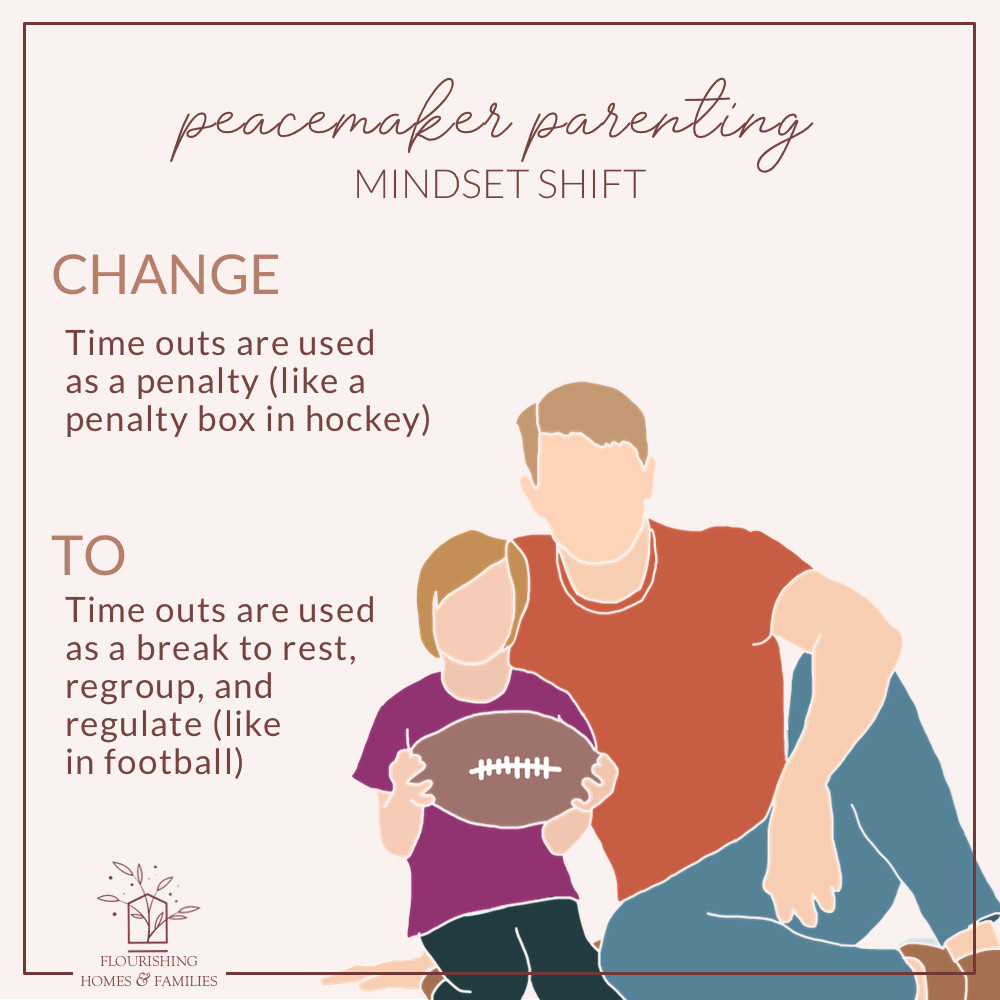
WHY THIS MINDSET MATTERS:
ISOLATION VS. CO-REGULATION
Sending a child to their room or a timeout isolates them for being dysregulated, which is largely outside their control. Their central nervous system learns how to calm down by being in the presence of a calm adult nervous system, a process called coregulation. They may come out of timeout no longer screaming or crying, but their nervous system likely will not have truly calmed down, which keeps them in a cycle of big feelings > bad behavior > time out.
PUNISHMENT VS. DISCIPLINE
Isolating a child for their behavior or immature expressions of feelings punishes them for what they did wrong, but it doesn't teach them how to do better. Discipline requires us to teach (disciple) them and guide them towards maturity. A time-in is essentially a collaborative time-out, and it provides an opportunity to teach a child through difficult situations.
SELF-CENTERED VS. TEAM-CENTERED
Time-out in the form of isolation teaches the child to focus on themselves and their behavior. Approaching timeout as a team-building opportunity (like in football) teaches a child to be aware of the family as a whole, and allows children and caregivers to learn from each other and problem-solve together.
WHAT AGES ARE TIME-INS BEST FOR?
Time-Ins are especially helpful for toddlers and preschoolers due to their under-developed skills of self-regulation. As children enter middle childhood, they will begin to grow their ability and capacity for self-regulation, meaning they will not need the help of a parent or caregiver quite as often. However, neurodiverse children, as well as kids who are still learning how to calm their nervous systems, may need a supportive adult to guide them.
REMEMBER - THE KEY TO AN EFFECTIVE TIME-IN ISN'T A PRETTY SPACE OR HAVING LOTS OF TOOLS, IT IS YOU! So when it's really rough - taking a parent time out is totally okay! You can't help a child learn to regulate if you are dysregulated!

Emotions are an integral part of the human experience, and helping young children understand their emotions is an important part of parenting! By equipping them with emotional intelligence early on, we empower them to navigate life's ups and downs more effectively.
Parenting as a Peacemaker means we look first to Jesus. As both fully God and fully human, He experienced the full range of human emotion. From joy and delight to frustration and anger, from compassion and empathy to grief and anxiety, Jesus reveals to us that emotions are natural, neutral, and necessary.
Why Teach Children About Emotions?
Emotional Regulation: Teaching children to recognize and understand their emotions helps them learn how to manage and regulate them. This skill is essential for maintaining healthy relationships, making thoughtful decisions, and coping with stress.
Improved Communication: When children can express their feelings effectively, it enhances communication with peers and adults. They can better articulate their needs and concerns, reducing frustration and misunderstandings. This also helps mitigate emotional outbursts that become physical.
Empathy: Understanding their emotions also fosters empathy, as children become more attuned to the feelings of others. Empathetic children are more likely to build strong, positive relationships and contribute positively to their communities. Remember, this is something that grows and matures over many years, and is largely dependent on brain development!
Conflict Resolution: Emotional awareness equips children with the tools to resolve conflicts peacefully. They can identify the emotions driving a disagreement and work towards finding solutions that address everyone's needs and concerns.
Practical Activities to Teach Children About Emotions
The Emotion Thermometer: Use a thermometer to help children gauge the intensity of their emotions. This visual aid makes discussing emotions easier and more concrete. Encourage them to point to the temperature that matches how they feel, from icy-cold (calm) to blazing-hot (angry).
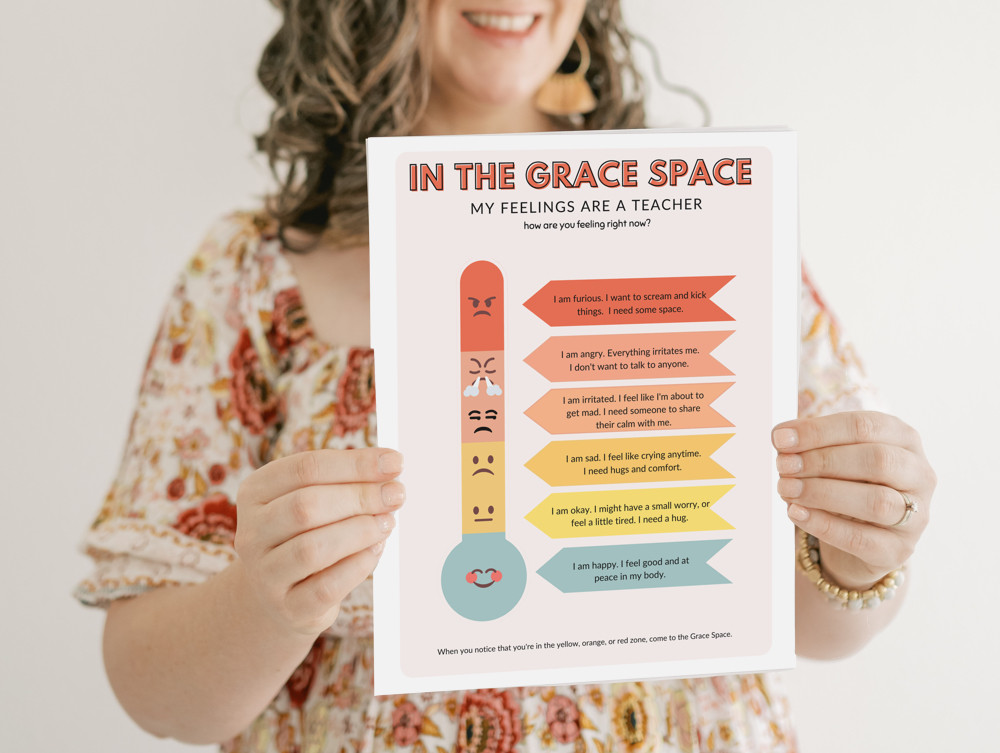
Emotion Charades: Play emotion charades by acting out various emotions without using words. This fun game helps children recognize and express emotions through body language and facial expressions.
Feelings Faces Art: Create a "Feeling Faces" art project. Provide magazines or printouts of different facial expressions and ask children to make a collage of various emotions. This activity encourages discussion about emotions while being creative.
Feelings Flashcards: Craft a set of emotion flashcards with pictures depicting different emotions. Show these cards to children, ask them to identify the emotion, and share a time when they felt that way. This helps them connect emotions to their own experiences.
Books + Stores Read books with emotional themes together. After each story, discuss how the characters felt and why. Encourage children to relate the emotions in the book to their own experiences and feelings.

Teaching children about emotions is a sacred journey of nurturing their hearts and souls. It's an opportunity to help them develop not just emotional intelligence but also a deeper understanding of themselves and their place in the world. Just as Jesus embraced and understood the emotions of those He touched, we can guide our children toward emotional maturity with a gentle, Jesus-centered spirit. By doing so, we provide them with a strong foundation for emotional well-being and for living out the teachings of Christ in their daily lives.
In nurturing a child's emotional intelligence, we equip them to better serve others, build lasting relationships, and walk in the light of God's love.
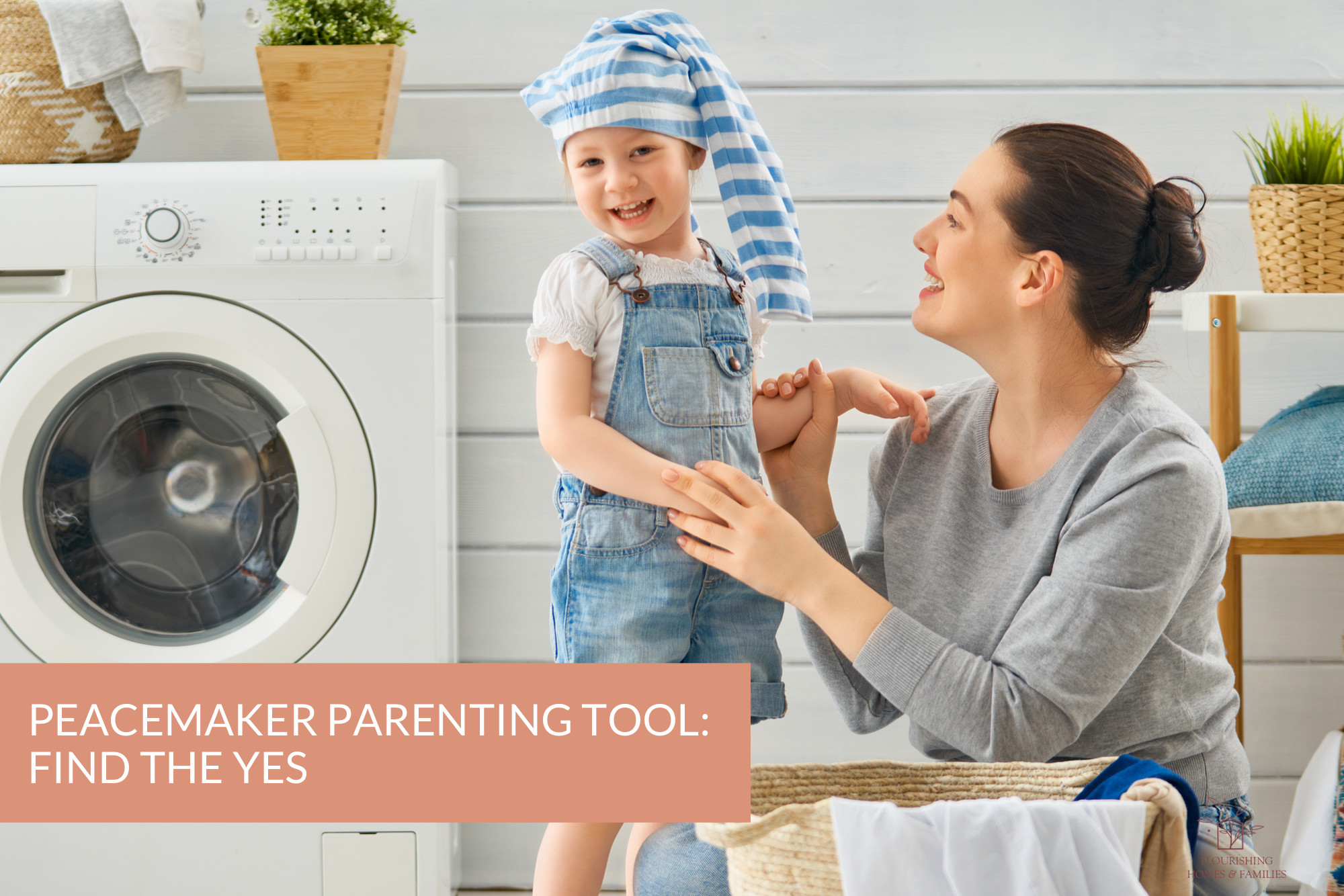
In the fast-paced world of parenting, it's easy to find ourselves uttering those familiar words: "No," "Don't," and "Stop." But did you know that these seemingly harmless words can trigger a cascade of stress-inducing reactions in both your child's developing brain and your own? In this blog post, we'll explore the power of "yes" and why telling children what to do, rather what not to do, can be a game-changer in cultivating harmony in your home.
THE SCIENCE BEHIND "NO"
When we constantly resort to "no," we unwittingly release a slew of stress-producing hormones and neurotransmitters in both our children's and our own brains. These chemicals can immediately interrupt crucial brain functions, leading to diminished logic, reason, language processing, and communication. To make matters worse, a disapproving frown when saying "no" can release even more stress hormones, contributing to increased anxiety and irritability. Ultimately, this can undermine the precious bonds of connection and trust between you and your child, which ultimately can result in more power struggles!
THE SCIENCE BEHIND "YES"
Of course, we're not suggesting that you should never say "no" to your child; that's simply unrealistic. No is a complete sentence and children do need to learn it! (Though you may have noticed your young child has most definitely learned the power of "no!" and you hear it quite often!)
Rather than relying on "no", we suggest a powerful alternative: the art of finding the "yes" and telling your little ones what to do rather than what not to do.
Here are some practical examples to illustrate the shift:

THE PATH TO PARENTING AS A PEACEMAKER
"Find The Yes" is just one of the valuable tools we're excited to share in our upcoming Peacemaker Parenting Preschoolers workshop this month. If you're THE parent of a 3-5 year old who is seeking to parent with peace and purpose while breaking generational cycles of harsh parenting and physical punishment, this workshop is designed specifically for you.
